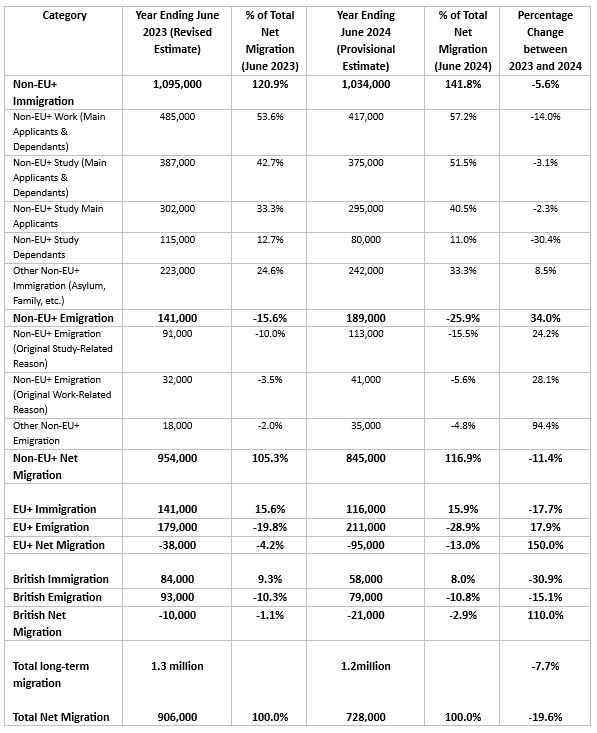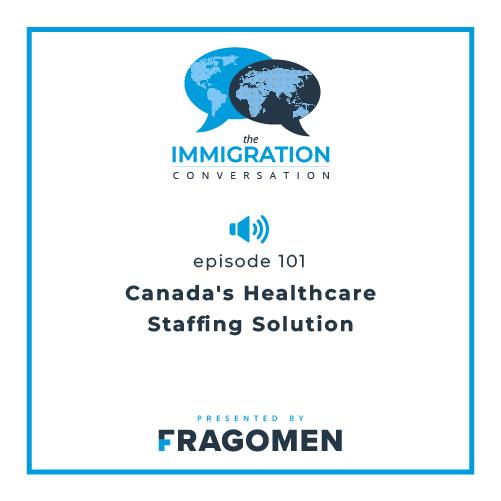From Record Highs to Early Decline: Understanding the UK’s Shifting Net Migration Trends
December 4, 2024
By: Shuyeb Muquit
Last week, the Office for National Statistics (ONS) revealed revised figures showing UK net migration reached a record-breaking 906,000 in the year ending June 2023. This figure represents the difference between those entering and leaving the UK for more than 12 months during that period.
The news prompted sharp criticism from the Prime Minister, who attributed these levels to policies of the previous government and announced plans for a White Paper to reduce immigration—a recurring theme in UK political discourse (see Fragomen’s earlier blog on the topic here).
Simultaneously, provisional ONS data for the year ending June 2024 showed net migration had dropped nearly 20% to 728,000. It is this downward trend that warrants closer scrutiny to understand its implications for UK immigration policy.
Balancing policy and strategy: Insights from the MAC
In its 2023 end-of-year report, the Migration Advisory Committee (MAC), the government’s independent immigration policy advisor, emphasised focusing on the composition of migration and its economic impacts, rather than net migration numbers alone. Ignoring these nuances risks poor policy decisions that may harm sectors dependent on immigration, especially amid constraints in other areas of public policy.
Madeleine Sumption, Director of the Migration Observatory at Oxford (and a MAC member), reiterated this in Fragomen’s Horizon Election Conversation series. She stressed the need for clearer debates linking overall migration levels to individual visa categories. Immigration policies involve trade-offs, and decisions should be informed by detailed data on specific impacts.
The government has shown some agreement with this thinking. As noted in this earlier blog, although seeking to reduce numbers, it has avoided setting explicit net migration targets, indicating acknowledgment that optimal immigration levels depend on strategic needs. This stance was reiterated during the press conference on the ONS data. The MAC is also conducting sectoral reviews to assess reliance on immigration. However, public messaging often struggles to reconcile this nuanced approach with political commitments to reduce migration, as seen in the Prime Minister’s press conference remarks.
Analysing the shift: 2023 record highs and early signs of 2024 decline
The table below, based on ONS data, compares the composition of net migration for the years ending June 2023 and June 2024, highlighting key trends:
Net Migration Composition: June 2023 vs June 2024

-
-
- EU+: This category includes nationals from all EU countries plus Norway, Iceland, Liechtenstein, and Switzerland.
- Non-EU+: This category includes all nationalities except those included in the EU+ category and British nationals.
- Work (Total): Includes both main applicants and dependents arriving for work-related reasons.
- Study (Total): Includes both main applicants and dependents arriving for study-related reasons.
- Asylum: This refers to non-EU+ nationals who have applied for asylum within a year of arriving in the UK. It includes those arriving through regular and irregular routes.
- Other Reasons: For non-EU+ migrants, this combines those arriving for family, humanitarian, and other unspecified reasons. This data is based on initial visa types and may not reflect subsequent changes in a person's reason for staying in the UK.
-
What happened in 2023?
The 2023 record figures were largely driven by non-EU migration. The post-Brexit immigration system, with relaxed salary thresholds and an expanded Health and Care Worker visa route, coincided with post-pandemic economic recovery, boosting demand for workers and students. Additionally, many individuals fleeing the Ukraine conflict contributed to the total.
Indeed, the ONS revised its 2023 figures upwards to account for previously omitted arrivals from Ukraine, highlighting the exceptional circumstances behind the increase. Such figures are unlikely to reflect a long-term trend.
What explains the 2024 decline?
By 2024, non-EU migration, though still the largest contributor, saw an 11.4% decline. Numbers of dependents accompanying international students dropped by 30.4%, while work-related arrivals fell 14.0%.
Stricter immigration policies introduced in 2023 began taking effect. These included bans on family dependents of most students and care workers, as well as higher salary thresholds for private-sector jobs. Home Office data showed a 32% drop in visa grants between mid-2023 and mid-2024, with Health and Care Worker visas falling by 85%.
Rising emigration, especially among international students completing their studies, further contributed to the decline. EU and British net migration figures remained negative, with more people leaving than arriving.
The bigger picture
The record 2023 net migration figures stemmed from extraordinary circumstances and should not dictate long-term policy.
The 2024 figures reflect only the early effects of policy changes, which were partially implemented during the period. As these measures take full effect, further reductions in net migration are likely.
Immigration remains critical to the UK’s economy and society. Skilled migration addresses labour shortages, particularly in healthcare, where domestic training cannot meet demand. International students support higher education funding and drive innovation, while humanitarian migration demonstrates the UK’s global commitments.
Even the UK government has highlighted immigration as an asset in its pitch to investors, noting the country’s “strong, diverse and highly-skilled workforce” supported by an immigration system that attracts top talent, making the UK one of the most attractive destinations for skilled workers in the G20.
Public opinion also reflects a nuanced view. According to the latest Ipsos/British Future Opinion Tracker, while a majority express a desire to reduce overall net migration, there is widespread support for migration related to work, study and humanitarian needs. This suggests a recognition of the balance required to sustain economic and societal contributions.
Looking ahead
The forthcoming White Paper offers an opportunity to redefine migration policy, prompted by the 2023 figures. However, the factors driving the rise have largely been addressed, with results already visible in the 2024 data. The key question is whether further reductions are necessary—or desirable—given the UK’s strategic needs and constraints in other policy areas.
Policymakers must shift the conversation from simply reducing net migration to a balanced, evidence-driven approach. This involves considering the composition of migrants and aligning policy with long-term national interests.
Business must also play its part – in furnishing data requisite to establish its needs and highlight its recourse to immigration is not automatic; that it is making the effort requisite to develop the domestic market. Transparent communication and action by both by the government and business is essential to build public understanding and support for immigration.
Indeed, given issues around public trust, this may be a time for considering the re-introduction of the Resident Labour Market Test so that the next time migration figures are released the public can be confident this is not at the cost of forgetting the local labour market.
Fragomen will continue to monitor and provide updates on these developments.
Need to know more?
For questions regarding the UK immigration system, please contact UK Government Affairs Strategy Lead Shuyeb Muquit at [email protected].
This blog was published on 4 December 2024, and due to the circumstances, there are frequent changes. To keep up to date with all the latest updates on global immigration, please subscribe to our alerts and follow us on LinkedIn, X, Facebook and Instagram.















